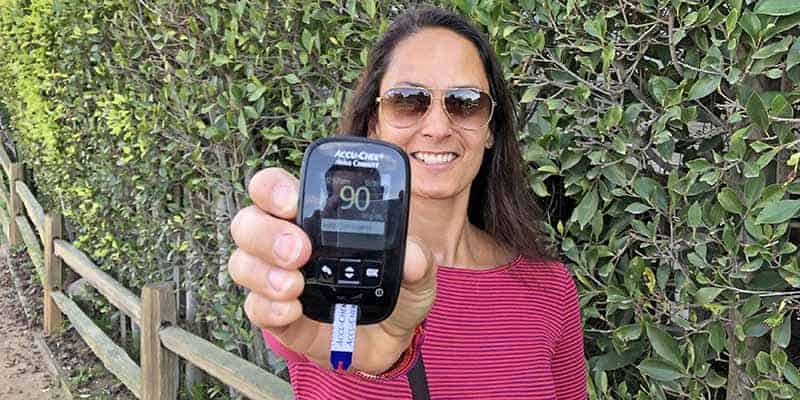Blood sugar ranges (sugar) ranges are an essential a part of your general well being and the physique’s capability to perform correctly.
For these of us with diabetes, striving to realize “regular” blood glucose ranges is an hourly monitoring. And that is not simple.
On this article, we’ll take a look at the traditional blood glucose ranges and goal ranges in folks with out diabetes, in addition to suggestions for blood glucose objectives for folks with pre-diabetes, kind 1 diabetes, and kind 2 diabetes.
Regular blood glucose vary for folks with out diabetes (chart)
For folks with out diabetes kind, blood glucose ranges are typically fasting between 70 and 99 mg/dL (3.9 to five.5 mmol/L) and beneath 140 mg/dL (7.8 mmol/L) after meals.
In line with the NIH, the traditional blood sugar vary for folks with out diabetes is as follows:
| Fasting blood sugar (for instance, the morning earlier than consuming) | Lower than 100 mg/dl (5.6 mmol/l) |
| 1-2 hours after meal | Lower than 140 mg/dl (7.8 mmol/l) |
| 2-3 hours after meal | Lower than 100 mg/dl (5.6 mmol/l) |
Advisable blood glucose ranges for diabetic sufferers (chart)
In line with the ADA, the next are the generally advisable blood sugar ranges for folks with diabetes:
| Fasting blood sugar (for instance, the morning earlier than consuming) | 80-130 mg/dl (4.4-7.2 mmol/l) |
| 1-2 hours after meal | Lower than 180 mg/dl (10.0 mmol/l) |
For extra data on fasting and post-grain blood sugar ranges, see beneath. Blood glucose stage: Targets for blood glucose stage and A1C.
How are you aware what your blood sugar ranges are?
Except it’s fairly excessive or low, you typically can not sense what your blood sugar stage is. And in reality, it’s possible you’ll not even be capable to inform from bodily signs when your bodily signs are excessive or low.
The easiest way to know your blood glucose stage is to examine it with a standard glucose meter or use a CGM (steady glucose monitor) gadget.
For glucose meters, use the lancet to make your finger scent, put a drop of blood into the take a look at strip, then insert the strip into the meter to learn. With CGM, measurements are taken from interstitial fluid (intercellular fluid) roughly each 5 minutes through a sensor inserted slightly below the pores and skin.
Prognosis of pre-diabetes, kind 1, and kind 2 diabetes
Under are some assessments that healthcare suppliers can use to find out if they’ve diabetes.
Exams used to diagnose diabetes
Fasting plasma glucose take a look at
This take a look at normally measures glucose ranges at a single time level for at the least 8 hours after fasting (no consuming or ingesting apart from water).
Random Glucose Take a look at
This take a look at measures glucose ranges at a single time level and could also be given at any time, whether or not or not you fasted.
Oral Glucose Tolerance Take a look at (OGTT)
On this take a look at, blood samples are taken for at the least 8 hours after fasting. Subsequent, drink a liquid containing sugar and take one other blood pattern after 2 hours to see how your blood sugar ranges have modified.
(For pregnant folks, glucose is checked for 2-3 hours each hour to check for gestational diabetes.)
A1C Take a look at
This blood take a look at displays common glucose ranges over the previous 2-3 months. You’ll be able to eat and drink earlier than taking the A1C take a look at.
Repeated assessments are normally mandatory to substantiate the analysis of diabetes.
Take a look at outcomes for diagnosing diabetes (chart)
In line with the ADA, the next blood glucose ranges and A1C outcomes (a measure of glucose management over the previous 2-3 months) are used to diagnose pre-diabetes and diabetes.
| A1c | Fasting glucose | Two hours after meal | |
| Pre-sugar | 5.7-6.4% | 100-125 mg/dl (5.6-6.9 mmol/l) | 140 mg/dl to 199 mg to dl (7.8-11.1 mmol/l) |
| Diabetes (Kind 1 or Kind 2)) | Over 6.5% | 126 mg/dl (7.0 mmol/l) or extra | 200 mg/dl (11.1 mmol/l) or extra |
For extra details about diagnosing diabetes, see beneath. Forms of diabetes.
please word: Kind 1 diabetes tends to develop in a short time. Which means by the point signs are felt, blood glucose ranges are all the time nicely above 200 mg/dl. For many individuals, signs happen so shortly that they’re dismissed as a chronic flu or one other seemingly frequent virus.
By the point blood glucose ranges are checked, many individuals with undiagnosed kind 1 diabetes might have ranges above 400 mg/dL.
When you suspect that you just or a liked one has kind 1 diabetes, instantly entry major or emergency care and hunt down a urine take a look at to measure your ketones along with checking your blood sugar and A1C.
Learn extra about ketones within the analysis: The right way to keep away from diabetic ketosidosis (DKA).
Your A1C and blood sugar goal
Managing any kind of diabetes is far more sophisticated than telling an individual to present insulin and preserve blood sugar inside X and X mg/dl. When you’ve lived with diabetes for quite a lot of days, you in all probability already know this.
What’s A1c?
“A1C, also referred to as hemoglobin A1C, HBA1C, glycation hemoglobin, or glycohemoglobin, is a blood take a look at that measures the common blood glucose stage over the previous two to 3 months.”
This take a look at displays glucose hooked up to hemoglobin (a protein in pink blood cells) for the previous 2-3 months, however blood glucose ranges for the 2 weeks main as much as the A1C take a look at are essentially the most affect on outcomes. Primarily, excessive blood glucose ranges throughout this era improve glucose binding to hemoglobin.
Convert A1C to blood sugar ranges
This straightforward calculator from ADA lets you convert the most recent A1C outcomes to “EAG” or “estimated common glucose stage”.
You too can use this translation when working to enhance A1C and obtain close to regular blood glucose ranges.
For instance, if 6.0 p.c A1c is thought to correspond to a mean blood glucose stage of 126 mg/dL (7.0 mmol/L), you may take a look at present blood glucose ends in CGM and meter to establish occasions which can be typically increased than that stage.
| A1c | Eag |
| 6% | 126 mg/dl |
| 7% | 154 mg/dl |
| 8% | 183 mg/dl |
| 9% | 212 mg/dl |
| 10% | 240 mg/dl |
| 11% | 269 mg/dl |
| 12% | 298 mg/dl |
Regular blood glucose ranges in folks with out diabetes could cause A1C beneath 5.6%.
Solely ten or two years in the past, it was uncommon for folks with kind 1 diabetes to realize A1C outcomes of lower than 6.0%.
Due to new insulin and higher applied sciences akin to CGM, smarter insulin pumps, and hybrid closed-loop know-how (which permits for insulin doses to be mechanically supplied), as extra folks with diabetes are actually capable of safely obtain A1c ranges within the increased 5% vary.
Why is your A1C essential?
In brief, A1C is among the most clear indicators of the chance of creating diabetic problems akin to neuropathy (neuropathy), retinopathy (kind of eye illness), nephropathy (renal illness), heart problems, and extreme infections that require therapeutic in any a part of the physique.
For instance, small toe cuts can develop into contaminated as a result of excessive blood sugar, which could be tough to treatment, and may develop into so extreme that the an infection requires amputation.
Common ADA tips advocate A1C ranges beneath 7.0% to stop diabetes-related problems. Bringing A1c nearer to six.0% can additional cut back the chance of microvascular problems (people who affect small blood vessels), akin to people who have an effect on the eyes (retinopathy), kidneys (nephropathy), and nerves (neuropathy).
Some folks with diabetes are aiming for A1C ranges beneath 5S. Particularly those that comply with strict low-carb diets just like the ketogenic and Bernstein diets. Nevertheless, this has not been confirmed in analysis to be notably mandatory, neither is it moderately achievable for the bigger inhabitants of individuals with diabetes.
It is usually essential to do not forget that blood glucose ranges and A1c are data indicating whether or not modifications in components akin to insulin, metformin, diet, or different diabetic drugs, akin to bodily exercise, are mandatory.
When you do not just like the quantity proven in your glucose meter or A1C outcomes, use that quantity as a motivation and make modifications (with the help of the diabetes care crew) in a manner that safely manages diabetes to realize completely different outcomes.
Decide the correct A1C objective for you
Simply because a blood glucose vary of 70-130 mg/dL (3.9-7.2 mmol/L) is taken into account the healthiest for diabetics, it does not essentially imply that it’s the proper goal vary for you.
The explanation this will not be the correct objective for you is that very tight glycemic management in folks taking insulin can probably result in frequent hypoglycemia (hypoglycemia).
Attaining very tight glycemic management typically requires strict dietary planning, very frequent blood glucose monitoring, correct drug administration, and sometimes years of expertise finding out blood glucose ranges.
A1C objectives ought to be set in shut session with a medical crew that can assist you stability the advantages and dangers of various targets based mostly in your well being, way of life and preferences.
Aged folks with cognitive or practical limitations or extreme comorbidities (main further well being issues) might have a decrease A1C goal of <8%.
It is usually price noting that as diabetes administration evolves, A1C targets can change over time.
A1C objectives have to be individualized
“The objectives of A1C ought to be individualized based mostly on particular person competence, dangers and former expertise,” explains the founding father of built-in diabetes and the authors of “MS, CDCES”, “CDCES”, “CDCES” and “CDCES” and “CDCES”.Consider it like a pancreas“.
“For instance, we typically purpose for very tight A1C ranges throughout being pregnant, and purpose to be a extra conservative goal for younger kids and older adults.”
Scheiner highlights key components that may justify aiming for a better A1C, akin to recognition of hypoglycemia, the place diabetics not really feel the standard warning indicators of hypoglycemia.
Hypoglycemia can pose a critical threat of extreme hypoglycemia, which could be life-threatening. To cut back that threat, we purpose for a better goal blood glucose vary.
“People who find themselves not conscious of great hypoglycemia ought to goal increased blood glucose ranges than those that can extra successfully detect and handle hypoglycemia,” provides Scheiner.
“And definitely, anybody who runs A1C in double digits (over 10%) shouldn’t goal 6% A1C for fairly a while. It is higher to set modest, practical, achievable objectives.”
Examine a1c discount: The right way to decrease A1c and The right way to decrease A1C naturally.
Your blood sugar ranges aren’t only for what you eat
It is easy to consider that your blood sugar ranges are solely affected by what you eat and the way a lot you train, however folks with kind 1 and kind 2 diabetes who examine steadily can let you know in any other case.
That is particularly essential to bear in mind when your blood sugar ranges and objectives. It is because there are particular variables and challenges that have an effect on blood glucose ranges which can be all the time uncontrollable.
for instance:
- Menstrual cycle: It typically will increase blood sugar and insulin wants
- Adrenaline rushes from aggressive sports activities, intense debate, curler coaster rides and different intense conditions: Improve your blood sugar and insulin wants
- Colds and different diseases: Often raises blood sugar and insulin wants
- Hormonal modifications as a result of adolescence and wholesome development in younger adults: Will increase blood sugar and insulin wants
- Injury that will increase general irritation ranges: Will increase blood sugar and insulin wants
- Gluconeogenesis throughout anaerobic train: Will increase blood sugar and insulin wants
Whereas these components affecting blood glucose ranges can’t be prevented, they might help you’re employed with the diabetes care crew to regulate insulin, different diabetic drugs, diet and exercise ranges to compensate you once they happen.
For instance, when engaged in anaerobic workout routines akin to weightlifting, many individuals with kind 1 diabetes really feel that they should take small bolus earlier than or throughout coaching, as non-sick train can really elevate blood sugar ranges.
Closing Ideas: Are you continue to irritated by your blood sugar and A1c outcomes?
Your blood sugar ranges and your insulin and medicine wants by no means keep in a single place. As you acquire weight or shed some pounds, your insulin and medicine wants change. Extra lively or lively will change your wants. Make dramatic or minor modifications to diet and alter your wants.
It’s important to work together with your diabetes healthcare crew and diabetes coach to indicate you the best way to change your whole diabetes administration plan. Diabetes is a lifelong studying course of.
Take a deep breath and maintain on. When you don’t love what you are on a glucose meter, do not get mad…examine! Take good notes, work together with your crew and make modifications to realize your objectives.











